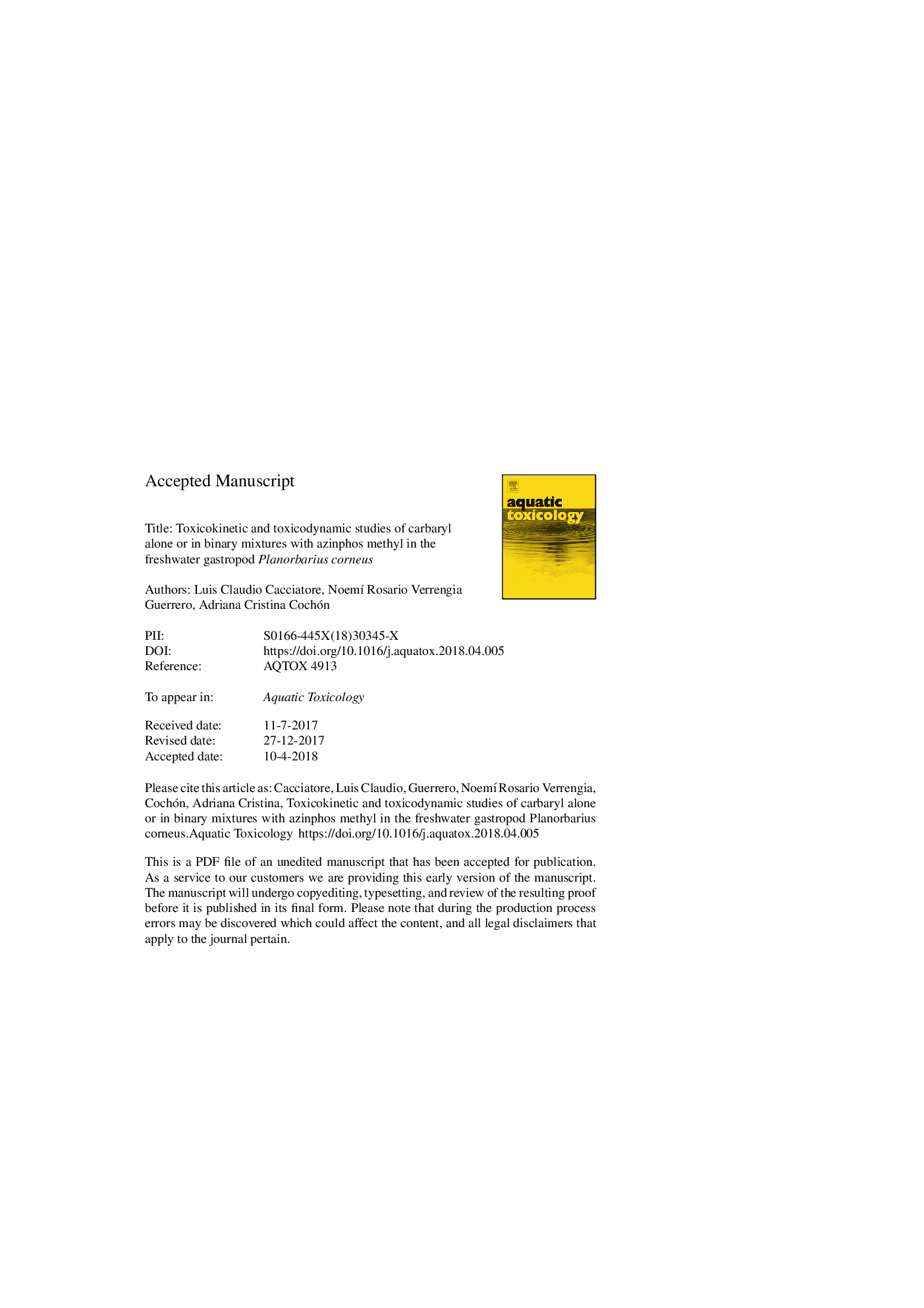| Article ID | Journal | Published Year | Pages | File Type |
|---|---|---|---|---|
| 8883762 | Aquatic Toxicology | 2018 | 38 Pages |
Abstract
Carbamate insecticides such as carbaryl and organophosphates such as azinphos-methyl share the ability to inhibit the activity of B-esterases. This study aimed to (1) assess the inhibitory effects of carbaryl on B-esterase activity in soft tissues and hemolymph of Planorbarius corneus; (2) establish whether binary mixtures of carbaryl and azinphos-methyl depart or not from a model of concentration addition on the inhibition of cholinesterase activity; (3) determine the bioconcentration and elimination of the pesticides. The results showed that exposure of gastropods to increasing concentrations of carbaryl (0.1-5â¯mgâ¯Lâ1) for 48â¯h inhibited cholinesterase activity in a concentration-dependent manner, with an EC50 of 1.4â¯Â±â¯0.3â¯mgâ¯Lâ1 and 1.2â¯Â±â¯0.1â¯mgâ¯Lâ1 for soft tissue and hemolymph, respectively. Carboxylesterase activity, measured with the substrates p-nitrophenyl butyrate and p-nitrophenyl acetate, was between 2.3 and 25 times more sensitive to carbaryl inhibition than cholinesterase activity. Binary mixtures corresponding to 0.5 EC50 carbarylâ¯+â¯0.5 EC50 azinphos-methyl and 0.75 EC50 carbarylâ¯+â¯0.75 EC50 azinphos-methyl produced inhibitions of cholinesterase activity similar to those of individual pesticides, following a model of concentration addition. Bioconcentration was analyzed using a one-compartment model. The absorption kinetics (k1) for both pesticides alone (1.4â¯mgâ¯Lâ1 of carbaryl or 1.8â¯mgâ¯Lâ1 of azinphos-methyl) or mixed (1.4â¯mgâ¯Lâ1 of carbarylâ¯+â¯1.8â¯mgâ¯Lâ1 of azinphos-methyl) were similar. The elimination kinetics ratio (k2) estimated for the pesticides alone or in the mixtures showed that carbaryl was eliminated 3.5 times faster than azinphos-methyl. These results suggest that exposure of Planorbarius corneus to binary mixtures of carbaryl and azinphos-methyl for 48â¯h follow a concentration addition model on inhibition of cholinesterase activity and that the pesticide mixtures do not change the toxicokinetic parameters of the parent compounds.
Keywords
p-NPBp-NPACyPB-esterasesBCFAcSChCarboxylesterasesDTNBCPFAZMPlanorbarius corneusMixturesOPsp-nitrophenyl butyratep-Nitrophenyl acetateAChEAzinphos-methylAcetylthiocholine iodideOrganophosphatesAcetylcholinesteraseCESToxicokineticsCytochrome P450bioconcentration factorCarbarylChlorpyrifosCHECholinesterase
Related Topics
Life Sciences
Agricultural and Biological Sciences
Aquatic Science
Authors
Luis Claudio Cacciatore, Noemà Rosario Verrengia Guerrero, Adriana Cristina Cochón,
